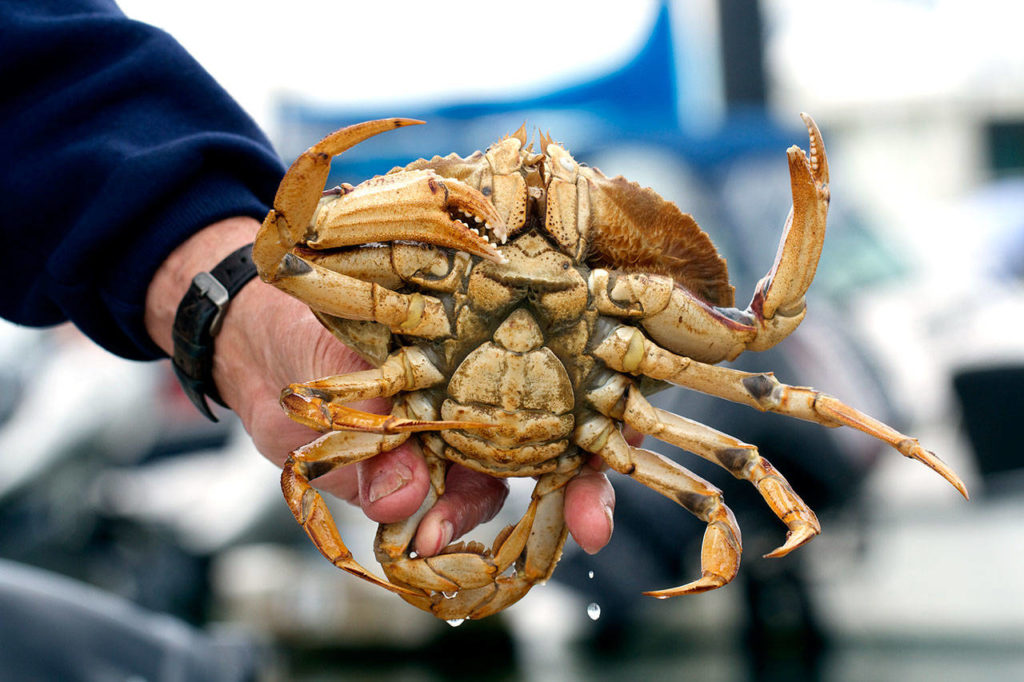EVERETT — Jerry Solie was leaving the Everett marina on a recent morning, explaining why he had dropped his crab pots in an out-of-the-way spot near Hat Island.
He had left the pots in 100 or so feet of water the previous day, letting them soak through the night with some fresh chicken in the bait box.
He likes fresh, rather than spoiled, meat, he said, because he’s always found it to be more effective.
“Somebody asked me if crab like smelly fish,” he said. “No, they don’t like smelly fish.”
The chicken resulted from a sale at the supermarket, but it could have been fish scraps, salmon heads, turkey, or other meat. “I’m just trading chicken for crab,” he said.
Solie added that he likes to place his pots away from the usual hot spots, basically seeking the less popular areas.
As we got closer to the island, it was clear that the place that had been vacant of crab pots the previous day had suddenly become a new hotspot. Crab pot buoys, some with little flags on the top, littered the area. And people on several boats were pulling pots and checking their catch.
Maybe Solie had just happened upon a hotspot. Or maybe the dropping of his pots had created one.
Either way, it was a good spot. The first pot had a dozen or so male, hard-shell crab of legal size, just five of which could be kept.
It’s crab season in much of Puget Sound, so crab buoys can be expected in many areas through most of the summer.
Area 8-2, which covers Port Susan and Port Gardner, opened June 30 and remains open until Sept. 3. Recreational crabbing is closed on Tuesdays and Wednesdays and pots must be out of the water on those days.
If you haven’t fished for crab before, it’s pretty simple. Most people use crab pots dropped from a boat, but you can also drop crab ring nets from docks or wade for crab with dip nets during a low tide. Ring nets need to be monitored regularly, because the idea is that you lure the crab over the net and then pull it in quickly.
Solie, 81, has been fishing for crab in Puget Sound for more than 70 years. “I grew up on Mission Beach (on the Tulalip Tribes Reservation) and we would go out wading for crab on the beach when I was 10 years old.”
These days he uses pots exclusively and said that he has had to drop them in deeper and deeper water in recent years to find crab.
He generally uses a pot in which he adds a length of heavy chain or other weight to keep it on the bottom. Fast moving tides can drag an unweighted crab pot a considerable distance, Solie said.
The pot, a wire cage with a one-way entry door, should be attached to at least 100 feet of weighted line to keep the line off the surface of the water. Add a buoy with your name and contact information and you’re in business.
It’s not uncommon to drop crab pots in fairly shallow water, but Solie said he usually goes down from 80 to 120 feet for his crab. He said commercial crabbers often go as deep as 300 feet.
While it sounds obvious, Solie warned that crabbers need to know the length of their line and the depth of the water.
“That’s the biggest cause of lost crab pots,” he said. “They drop it too deep and the buoy goes right underwater.”
Boaters need a depth sounder. And he also suggested crabbers mark the length of the line on the buoy so they don’t forget.
While nobody likes to give away a popular crabbing spot, the areas around Hat Island and Mission Beach can be good ones.
Crab pots and rigging are available at most sporting goods stores and cost from $25 to $100. Shellfish licenses come in various combinations and prices.
Talk to us
> Give us your news tips.
> Send us a letter to the editor.
> More Herald contact information.






























